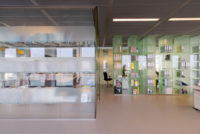Dirk Jan Postel/Kraaijvanger'Urbis; Universal Architecture Studio; and Royal Haskoning
Beijing, China
Even in a city that’s defined by walls—those of the Forbidden City, old courtyard homes, and the Great one to the north—the new Beijing residence of the Dutch ambassador stands out. That’s because it looks like one as you drive up to it. “The idea was to express a whole house as a single wall,” says Dirk Jan Postel, a principal in the Rotterdam-based firm Kraaijvanger Urbis that designed the project. Made of strips of black Mongolian stone, the building’s entry façade runs the entire length of the single-story house and extends beyond it in a majestic gesture. At night, the sobriety is broken by strips of colorful LED lights, which pay slight homage to the neon of the nearby Sanlitun Bar Street, an entertainment area popular with expatriates. Except for a cantilevered roof hovering above the impressive entry wall, the house and its spacious rear garden disappear behind the monolithic stone face. “You only get an idea of what’s behind,” Postel says.
The architect has designed a number of “primarily public” or highly transparent buildings, often wrapped in load-bearing glass, like his Temple de L’Amour II in Bourgogne, France. But in Beijing, Postel chose to emphasize privacy, a scarce commodity in diplomatic society. “As the ambassador here, you host parties of 40 people, perhaps twice or three times a week,” he says. “You cannot call that home.” To create a degree of privacy, Postel kept public spaces, like a salon and dining room, within the home’s central “representational” wing, and removed the living quarters to a smaller, western wing. Between the two sections, he designed a glassed-in winter garden, which, when viewed through a rectangular hole in the front façade, becomes a “not very literal symbol” of Dutch agricultural proficiency.
If the home’s front elevation only hints at transparency, the opposite side sings its praises. A floor-to-ceiling glass façade beneath the sweeping cantilevered roof offers visitors an immediate and almost unobstructed view of the large rear garden. From the garden, the house becomes a luminous, panoramic glass box. “It’s my most Miesian house yet,” says Postel. Because Beijing is located in a seismic zone, he had to convince the engineer that the load-bearing glass should be punctuated by slender steel columns rather than wider concrete ones, which would have detracted from the roof’s “suspension of gravity.” The architect also struggled to ensure structural precision, because a strong understanding of building physics “is still lacking in China,” says Postel. The home’s back garden, designed to survive harsh summers and winters, entices the eye with trees, flower beds, and bamboo surrounding a snaking “dry river” of grass, gravel, and concrete, conceived by artist Sjoerd Buisman. “The garden compensates for the closeness and protection of the walls,” says Postel.
Though he used a wall to shape the building, along the street, where most diplomatic residences hide behind imposing barriers, Postel rallied against the architecture of isolation. He designed a line of slender black posts that offer passers-by a generous view of the ambassador’s house. “This was crucial,” says Postel. “We hoped to break down walls all around the district.” Architecturally, there may be nothing more diplomatic.








